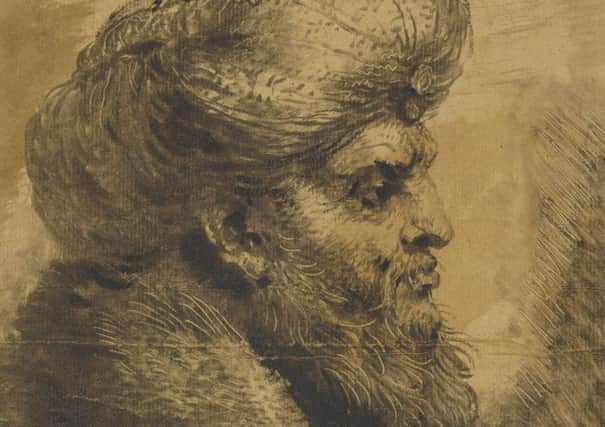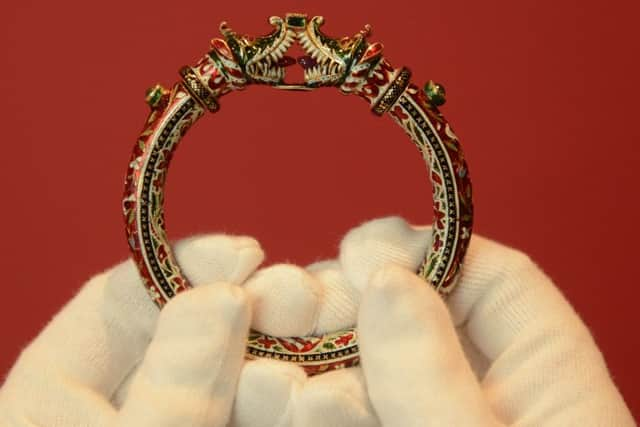Art review: Castiglione | Indian Encounters


Castiglione: Lost Genius
Queen’s Gallery, Edinburgh
Star rating: ****


Indian Encounters
National Museum of Scotland, Edinburgh
Star rating: ****
He came from Genoa and on one occasion when Giacomo Lomellini, doge of the city, rejected a commissioned altarpiece, but offered to pay for it nevertheless, Castiglione is reputed to have slashed it to ribbons in front of him vowing no Lomellini should ever have a work by him. On another occasion he and his brother had to flee Rome with nothing but the clothes they stood up in. Though we don’t know what made his flight so urgent, his notorious temper seems the most likely cause. So the title of the exhibition at the Queen’s Gallery in Edinburgh, Castiglione: Lost Genius, has two sides to it. On the one hand, who now has heard of Castiglione, though for all his cantrips he had quite a reputation in his lifetime? He is a lost genius now rediscovered in this show; but the other meaning is that he was perhaps a wasted genius and his extraordinary talent was a victim of his equally extraordinary temper.
Certainly this exhibition might give the impression that his career was unfulfilled. The Royal Collection, although built up over centuries, is not systematic. It has grown with the tastes of individual monarchs. George III was one who took an interest and he made a significant addition when he bought the collection of Consul Smith, the British Consul in Venice. This included among other things a fabulous group of Canalettos and more than 200 works on paper attributed to Castiglione. Almost 100 of them are in this show, but there is also one painting. Not in the catalogue, it was a surprise discovery made when someone suggested taking a closer look at a dark painting of Jupiter and Io (Io was a nymph turned into a cow by Jupiter to hide her from Juno’s jealous gaze.) Once cleaned, the picture turned out to be by Castiglione and also rather beautiful. Nevertheless with 100 drawings and only one painting, you would be forgiven for supposing that Castiglione never had an opportunity to do anything on a large scale. In fact he did paint altarpieces to match the best of his baroque contemporaries. Nevertheless, it is also true that it was the brilliance, the energy and the technical inventiveness of works on paper that earned the admiration both of his contemporaries and of future generations of artists; and he was, the catalogue tells us, very much an artist’s artist.
Advertisement
Hide AdBorn in Genoa, Castiglione worked there, in Rome, Venice and Mantua. In Rome he was a younger contemporary of Poussin, whom he admired and imitated, and of the other great painters of the Roman baroque. But while his painting style is elegant and very much of the period, his drawings are more remarkable. This is not so much for their elegance and precision as their fluency. You even see something of his fiery temperament in their tempestuous flow, an impression enhanced by the predominantly reddish colour of his technique of drawing with oil paint on paper. Applied to paper, oil from the paint tends to soak in and spread. It usually looks greasy and stained, but Castiglione developed a technique where this didn’t happen. The result has the richness of tone of oil paint, but the informality of drawing. Using this technique, his early work is mostly landscapes with figures and animals, a bit like the paintings of some of his Dutch contemporaries, but with added Roman elegance. Then he also began to treat more serious religious and classical themes. Whether it is a Madonna and Child with Angels or Circe with the companions of Odysseus turned into Wild Beasts, he always seems to improvise, pursuing expression rather than correctness. The result looks very modern and was much admired by artists like Watteau, Tiepolo and Fragonard. Ironically, however, the admirers became more famous than their model, the lost genius.
Castiglione was also a gifted and inventive printmaker. One of the first Italians to take notice of Rembrandt, and in a self-portrait etching, one of a number of character heads very much in the Rembrandt manner, he even makes himself look like his great Dutch contemporary. In bigger, subject etchings, like Finding the Bodies of Sts. Peter and Paul, for instance, he extemporises brilliantly on Rembrandt’s dramatic use of light and shade. While the subject of the etching Diogenes Searching For An Honest Man may reflect his sense of his own embattled position.
Castiglione also seems to have invented monotype: applying ink or paint directly to a printing plate, drawing into this and then printing the result. He had to work quickly while the paint on the plate was still wet, but this suited him and it shows off his deft and rapid execution. A monotype really only gives one good impression, but it can have a richness and drama which Castglione exploited to the full in prints like The Nativity with Angels.
A very different personality figures in a small exhibition at the National Museum. Maharaja Duleep Singh was the last maharaja of the Sikh empire, succeeding his father at the age of five. In 1849, just five years later, he was deposed by the British when they annexed the Punjab. The Koh-i-Noor diamond, although nominally a gift, was only the most notable piece of loot to end up in the hands of Queen Victoria. Poor Duleep Singh was brought to Britain to be kept as a kind of imperial pet. In the care of Sir John Login, a Scottish doctor, he converted to Christianity and lived part of the time in Perthshire. He was allowed to have enough of his jewellery back – a present of his own jewellery for his 11th birthday – to make a good impression when he dressed up in his Indian robes to perform at court. His son later sold most of these remaining possessions and some of them eventually passed by bequest to the museum. They include a beautiful gold pen case and gold and enamelled jewels decorated with rubies, emeralds and precious stones. They are lovely things, but clearly just a sad little remnant of what there once was.
The exhibition also includes a superb set of large miniatures acquired by Archibald Swinton. In an earlier stage in the establishment of the British Raj, Swinton was an unofficial ambassador of the East India Company at the court of the Mughal emperor, Shah Alam II. As interpreter he was involved in the Treaty of Allahabad in 1765, which marked the beginning of the Raj and the beginning of the end for the Mughal Empire. One or two of the objects Swinton brought home were actual loot. Writing implements from the emperor’s personal writing desk, for instance, were “found on a driverless elephant” after a battle between the troops of the East India Company and the emperor’s army in 1761. But the most spectacular objects in the show are the Swinton miniatures. They depict court life in the 1750s and include a landscape with the shah hunting and the Nawab of Bengal holding court with his son beside him. It is not clear how Swinton acquired these, but, richly adorned with gold leaf, they are lovely examples of the finest Indian court painting.
An epilogue is also provided by a contemporary painting, an imaginary portrait of Duleep Singh. He was the first Sikh to come to Britain and the picture is by the Singh Twins, modern British Sikhs who form an artistic double act. Altogether this show is a rather sad story of the fallout from British imperial expansion, but there is perhaps also some redeeming irony in the fact, unthinkable to Victoria and her imperialist cohorts, that for all its might, the British Raj proved no more durable than the gorgeous empires it overthrew.
• Castiglione until 8 February; Indian Encounters until 14 March